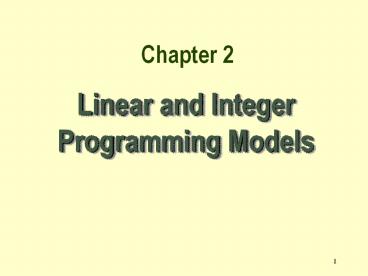Linear and Integer Programming Models - PowerPoint PPT Presentation
1 / 20
Title:
Linear and Integer Programming Models
Description:
There are no interactions between the decision variables (the ... Galaxy manufactures two toy doll models: Space Ray. Zapper. Resources are limited to ... – PowerPoint PPT presentation
Number of Views:160
Avg rating:3.0/5.0
Title: Linear and Integer Programming Models
1
Linear and Integer Programming Models
Chapter 2
2
2.1 Introduction to Linear Programming
- A Linear Programming model seeks to maximize or
minimize a linear function, subject to a set of
linear constraints. - The linear model consists of the
followingcomponents - A set of decision variables.
- An objective function.
- A set of constraints.
3
Introduction to Linear Programming
- The Importance of Linear Programming
- Many real world problems lend themselves to
linear - programming modeling.
- Many real world problems can be approximated by
linear models. - There are well-known successful applications in
- Manufacturing
- Marketing
- Finance (investment)
- Advertising
- Agriculture
4
Introduction to Linear Programming
- The Importance of Linear Programming
- There are efficient solution techniques that
solve linear programming models. - The output generated from linear programming
packages provides useful what if analysis.
5
Introduction to Linear Programming
- Assumptions of the linear programming model
- The parameter values are known with certainty.
- The objective function and constraints exhibit
constant returns to scale. - There are no interactions between the decision
variables (the additivity assumption). - The Continuity assumption Variables can take on
any value within a given feasible range.
6
The Galaxy Industries Production Problem A
Prototype Example(PP. 45)
- Galaxy manufactures two toy doll models
- Space Ray.
- Zapper.
- Resources are limited to
- 1000 pounds of special plastic.
- 40 hours of production time per week.
7
The Galaxy Industries Production Problem A
Prototype Example
- Marketing requirement
- Total production cannot exceed 700 dozens.
- Number of dozens of Space Rays cannot exceed
number of dozens of Zappers by more than 350.
- Technological input
- Space Rays requires 2 pounds of plastic and
- 3 minutes of labor per dozen.
- Zappers requires 1 pound of plastic and
- 4 minutes of labor per dozen.
8
The Galaxy Industries Production Problem A
Prototype Example
- The current production plan calls for
- Producing as much as possible of the more
profitable product, Space Ray (8 profit per
dozen). - Use resources left over to produce Zappers (5
profit - per dozen), while remaining within the marketing
guidelines.
- The current production plan consists of
- Space Rays 450 dozen
- Zapper 100 dozen
- Profit 4100 per week
9
- Management is seeking a production schedule that
will increase the companys profit.
10
A linear programming model can provide an
insight and an intelligent solution to this
problem.
11
The Galaxy Linear Programming Model
- Decisions variables
- X1 Weekly production level of Space Rays (in
dozens) - X2 Weekly production level of Zappers (in
dozens). - Objective Function
- Weekly profit, to be maximized
12
The Galaxy Linear Programming Model
- Max 8X1 5X2 (Weekly profit)
- subject to
- 2X1 1X2 1000 (Plastic)
- 3X1 4X2 2400 (Production Time)
- X1 X2 700 (Total production)
- X1 - X2 350 (Mix)
- Xjgt 0, j 1,2 (Nonnegativity)
13
2.3 The Graphical Analysis of Linear
Programming
The set of all points that satisfy all the
constraints of the model is called
a
FEASIBLE REGION
14
- Using a graphical presentation
- we can represent all the constraints,
- the objective function, and the three
- types of feasible points.
15
Graphical Analysis the Feasible Region
The non-negativity constraints
X2
X1
16
Graphical Analysis the Feasible Region
X2
1000
700
Total production constraint X1X2 700
(redundant)
500
Infeasible
Feasible
Production Time 3X14X2 2400
X1
500
700
17
Graphical Analysis the Feasible Region
X2
1000
The Plastic constraint 2X1X2 1000
700
Total production constraint X1X2 700
(redundant)
500
Infeasible
Production mix constraint X1-X2 350
Feasible
Production Time 3X14X2 2400
X1
500
700
Interior points.
Boundary points.
Extreme points.
- There are three types of feasible points
18
Solving Graphically for an Optimal Solution
19
The search for an optimal solution
Start at some arbitrary profit, say profit
2,000...
X2
Then increase the profit, if possible...
1000
...and continue until it becomes infeasible
Profit 4360
700
500
X1
500
20
Summary of the optimal solution
- Space Rays 320 dozen
- Zappers 360 dozen
- Profit 4360
- This solution utilizes all the plastic and all
the production hours. - Total production is only 680 (not 700).
- Space Rays production exceeds Zappers production
by only 40 dozens.































